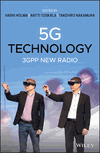5G Physical Layer
Summary
The 5G L1 design provides a capable and versatile radio design for different use cases and a large range of frequency bands. This chapter presents the 5G physical layer principles, including the mapping of the transport channel to the physical channel, 5G frame structure, and key physical layer procedures. Special emphasis is on the new features compared to Long Term Evolution (LTE), such as full support of beamforming, larger bandwidths, and a more flexible frame structure. The chapter also introduces the 5G channel coding solutions, physical layer procedures, and measurements as specified in 3GPP. The physical layer procedures with 5G have many new elements over LTE. One of the new areas is beamforming. The other key physical layer procedures are as follows: physical layer retransmission handling, power control and power sharing with dual connectivity, and timing advance. The chapter concludes with an overview of the physical layer aspects of the 5G UE capabilities.



